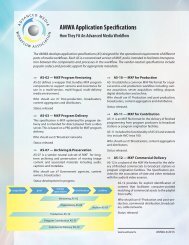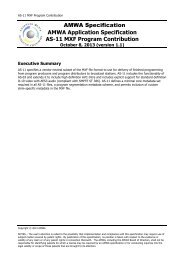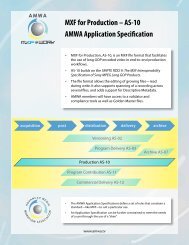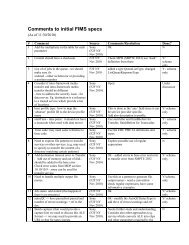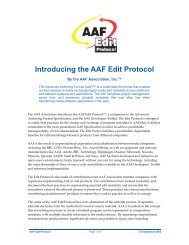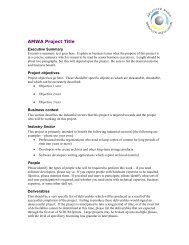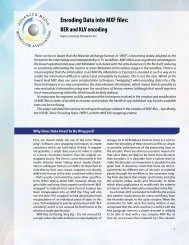You also want an ePaper? Increase the reach of your titles
YUMPU automatically turns print PDFs into web optimized ePapers that Google loves.
<strong>FIMS</strong> <strong>Media</strong> <strong>SOA</strong> <strong>Framework</strong> Phase1 (Preliminary)Since the system manages the storage and movement of a very large number of large files (sometimes millionsper project) it is important that an asset data repository be available as part of the system core functionality, oras an external (third party) service.There can be many copies of file instances and also many versions located in multiple island data storage areasin the system. There will also be many lower resolution video proxy files in the system representing the originalhigh resolution “camera negative” files or file sequences. These proxy files must be tracked and versioned aswell.9.4.2 Other <strong>Media</strong> Bus FeaturesReliable transfers are also critical, so the capability to provide check sums or other file verification technology isalso a function of the media bus.File naming and name management in Post Production workflows is a major issue. File names are oftenchanged when new instances are created to serve the needs of a specific creative task like Picture Editorial orDigital Intermediate. So the same file or sequence may exist in various parts of the system with different filenames. It is critical that all of these instances of the same essence be tracked and managed.Maintaining the correct metadata for any given file or file sequence (clip) as it passes through the manyprocessing stages in a media workflow is also a big problem. Many processes, both internal and outsourced (likeVFX) may change or strip off metadata from the essence and even change the identity of the objects involved.Maintaining a clear relationship between a media object and its original and modified or added metadata is veryimportant.Storage management is also critical due to the large number of large files in a 2K or 4K workflow. The systemmust facilitate the efficient use of the hierarchal storage system and assist is selecting files to be migrated totape library storage.9.4.3 M-SLAFor the treatment of <strong>Media</strong> Aware Bus in the <strong>FIMS</strong> <strong>Framework</strong>, the performance of elements on <strong>Media</strong> AwareBus (mainly storage devices) such as bandwidth, transfer speed, capacity, and available protocols are to bequeried by using a common format message.Based on this, a client such as service consumer and/or the media infrastructure service can select the storagedevice which is best suited to the client, and/or more precisely estimate the execution time it will request.This corresponds to SLA in a conventional IT-based <strong>SOA</strong> system and is referred to as M-SLA. Because thedetailed specifications of M-SLA need to be harmonized with SLA, it will be specified at a later date inaccordance with SLA developments.9.4.4 Automatic TransformIn the <strong>FIMS</strong> <strong>Framework</strong>, it will be possible for <strong>Media</strong>tion that resides in the <strong>Media</strong> Aware Bus to provideautomatic transformation by using the <strong>Media</strong> Descriptor. But since the support of automatic transformationdepends on the system design policy, it shall not be made mandatory in the <strong>FIMS</strong> <strong>Framework</strong>.Private committee documentWorking Draft for review by <strong>FIMS</strong> Rev v1, Nov-16-2010 Page 85 of 89



